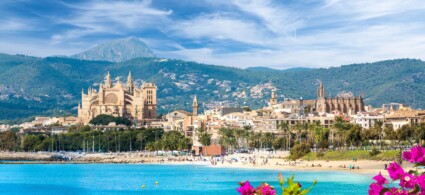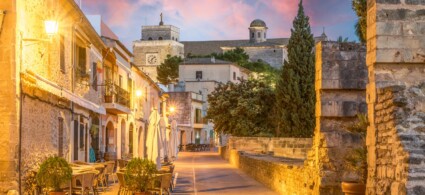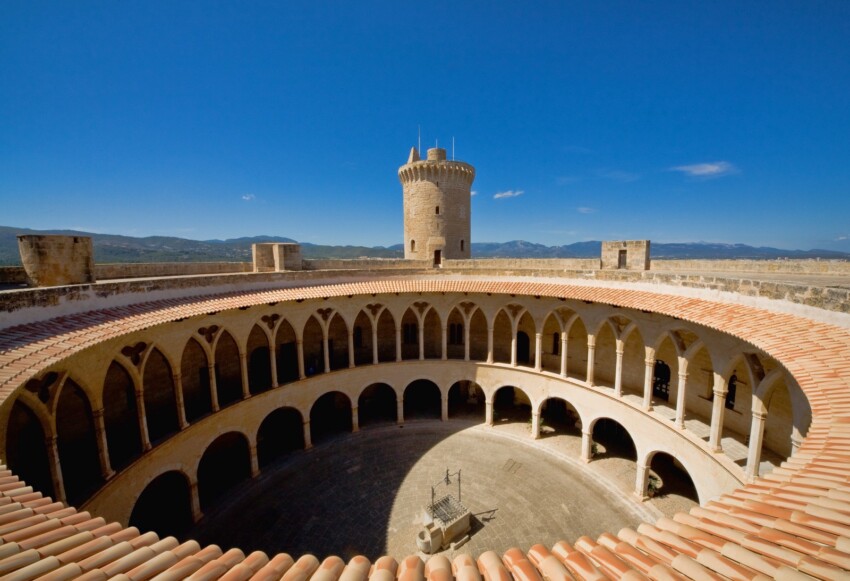

Known for its beach parties, crystal-clear sea, beachfront resorts and nightclubs, Majorca is also a place where you can discover small villages with ancient history, climb limestone mountains or admire Roman remains and Moorish relics.
Majorca, then, is not only the largest island in the Balearic archipelago but also a destination that holds a splendid historical, architectural and natural heritage. The opportunities here are many and captivate every type of tourist.
Ideal for holidays for couples but also for groups of friends looking for a good time, Majorca also appeals to families with children and travellers in search of wild landscapes. The island covers some 3,000 square kilometres that can be covered from north to south in about an hour’s drive.
Despite its small size, however, Majorca always manages to offer something new to discover and never ceases to amaze. Here, then, is a mini-guide of things to see during a stay on the island.
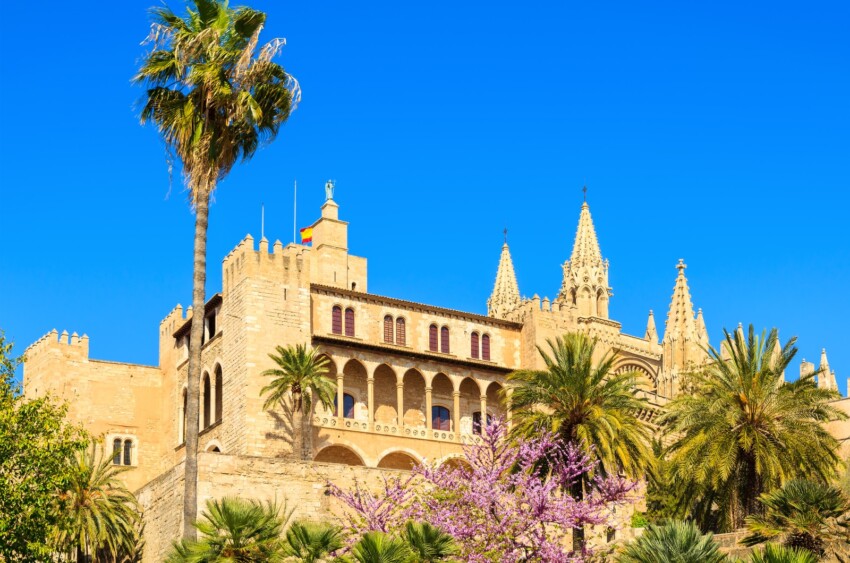
The discovery of the Island of Majorca can only start in Palma, capital of the entire autonomous community of the Balearic Islands. Here you can build a one- or two-day itinerary to discover the most beautiful sights such as the Cathedral of Santa Maria, also known as La Seu. This magnificent Gothic church overlooks the sea and is famous for its beautiful 12-metre diameter rose window that looks like an enormous eye.
Next to the church is the Almudaina Palace, the residence of the Spanish royal family when in Majorca. The heart of the city, however, is undoubtedly Casco Antiguo, the old town that comes alive especially in the evenings at aperitif time. This intricate network of narrow streets and alleys is characterised by the presence of historical buildings, courtyards, numerous churches and bars where you can enjoy a quiet cerveza.
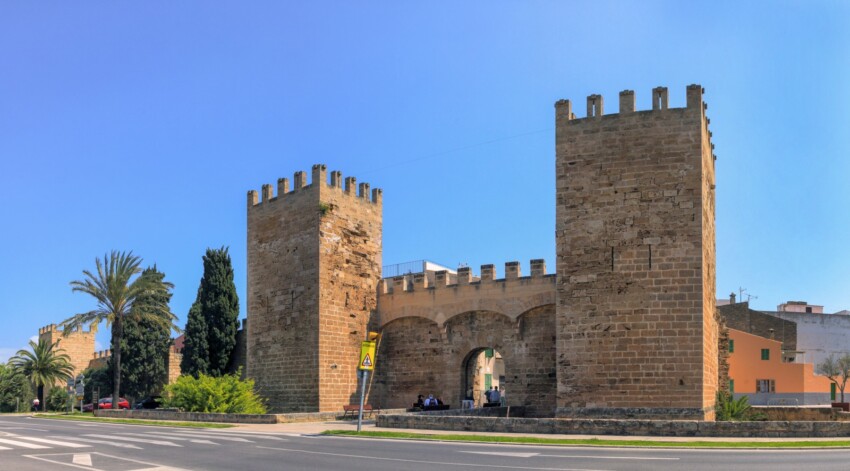
Majorca is famous for its beautiful pueblos, or small towns in which the traditions of the past still survive and where you can admire glimpses of authentic life. Alcudia is located along the north-east coast of Majorca and is one of the places where you can combine a cultural visit with relaxation on beautiful beaches.
The historic centre is still surrounded by medieval and Renaissance walls and holds the Plaza de la Constituciòn, the heart of the town. Walking through its narrow streets you can admire elegant palaces, the neo-Gothic Church of San Jaume, the Alcudia town hall and the Puerta del Muelle.
The harbour area is perfect for a bite to eat as it is home to numerous restaurants offering local cuisine. A short distance from the centre, however, you can visit the ruins of ancient Pollentia, which was the first Roman settlement on the island of Majorca. For a bit of relaxation, besides the harbour beach, you can also visit the wide sandy beach of Playa de Alcudia.
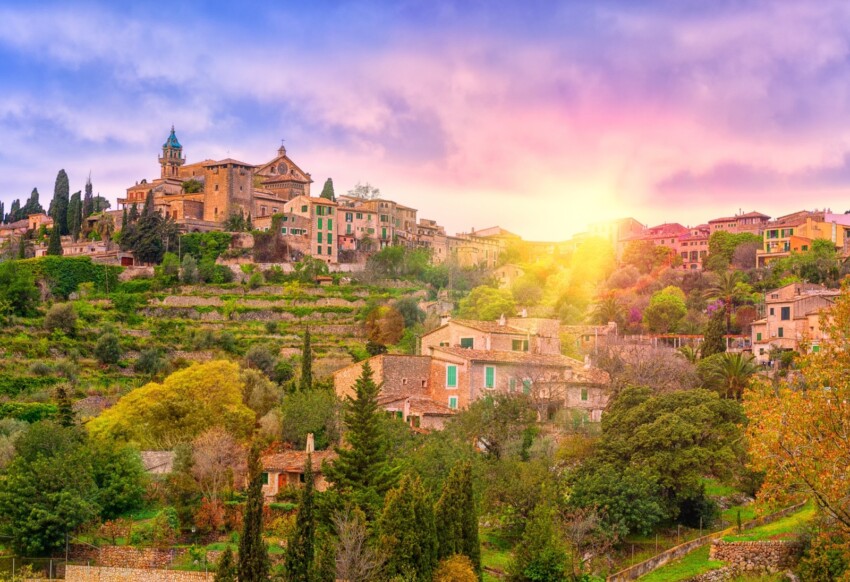
Valldemossa is one of Majorca’s most characteristic pueblos, rising at an altitude of 1064 metres amidst green hills. The town began as a small rural village that later developed around the church of Sant Bartomeu. In the 15th century, the Royal Palace of Valldemossa (Real Cartuja de Valldemossa) was built here and was later donated by James II to Carthusian monks. The latter transformed the building into a monastery known as the Cartuja de Jesús Nazareno. Over time, the monastery attracted not only many worshippers but also many artists such as the Polish composer Frederic Chopin and his lover George Sand. The Cartuja de Jesús Nazareno is a neoclassical style complex with a church boasting a Latin cross plan and housing above the high altar the image of Santa Catalina Thomás, considered the city’s patron saint.
Another attraction is the Palacio Rey Sancho, which was built by Jaime II at the beginning of the 14th century but has been extended several times over time. Inside, rooms with frescoes and many works of art are still perfectly preserved. A visit to the city can continue with the Monastery of Miramar (Monestir de Miramar), which was founded in 1276 to accommodate Franciscan monks who were learning foreign languages to then go on to evangelise Arab countries. Now the monastery has been turned into a museum that tells the story of this building and its founder Ramon Llull. From here, it is also possible to admire a truly breathtaking panorama of the surrounding area.
Like many other villages in Majorca, Valldemossa also has its own outlet to the sea: Port de Valldemossa. This old fishing village boasts an old-world atmosphere, with small moored boats, old houses and a quiet promenade.
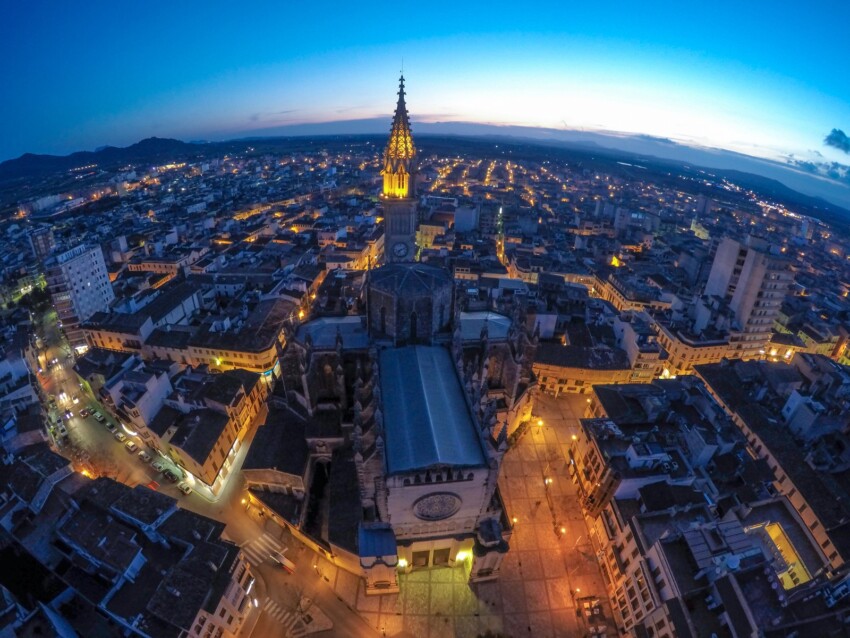
Manacor is the second largest town on the island and is popularly regarded by many as the perfect base for visiting Majorca if you want to stay in a town that is not too small, but away from the hustle and bustle of Palma. This resort is located along the east coast of the island and boasts many well-equipped beaches for families, as well as wilder and more isolated coves.
The town is particularly well known because it is home to the Manacor pearl factory (Perlas Majoricas), which has become one of the area’s most famous attractions. Perlas Majoricas, or Majorca Pearls, is one of the most famous Spanish brands in the world that produces the highest quality artificial pearls that reproduce the iridescence of natural pearls.
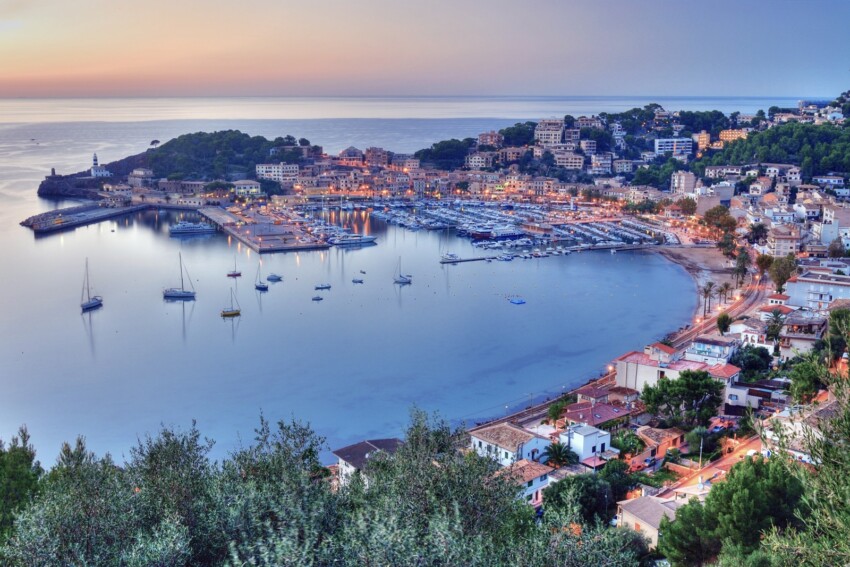
In the western part of the island of Majorca, surrounded by numerous citrus trees and the Sierra de Tramuntana, lies the quaint town of Soller, only 25 km from the capital. For years, this village could only be easily reached by sea, as there were no roads or streets by land to cross the mountains that rise all around the town.
It was not until the 20th century that first a railway and then a road were built to connect Soller with Palma de Mallorca. Nowadays, the town can still be reached via the old railway line on board a vintage train that passes through tunnels and valleys, offering wonderful views of the Sierra de Tramuntana. Alternatively, it is possible to reach Soller by car, via an evocative but quicker journey.
The small town (pueblo) has a quiet and hospitable atmosphere and is characterised by the presence of small shops, boutiques and tapas bars. The heart of Soller is Plaza de la Constituciòn where you will find the Iglesia de San Bartolomé, a majestic neo-Gothic building with a façade that surprises all visitors. Other things to see in the city include the Balearic Museum of Natural Sciences with its magnificent Botanical Gardens and the Modernist Museum Can Prunera.
From the city centre, you can then take the Tram de Soller to Puerto de Soller, which lies in a sheltered bay along the coast of the island. Here you will still find the harbour, which for years was the access point to the city, but also the place from which many traders’ boats departed. As well as walking through the narrow streets of this village and savouring the peaceful atmosphere, you can also admire the Picada Tower, a keep built in 1561 for defensive purposes and now a symbol of the village. There are also some beautiful beaches in Port Soller, such as Playa de Es Trves, the town beach with many facilities, bars and restaurants, and Playa d’en Repic, which, being further from the centre and only accessible on foot, is quieter.
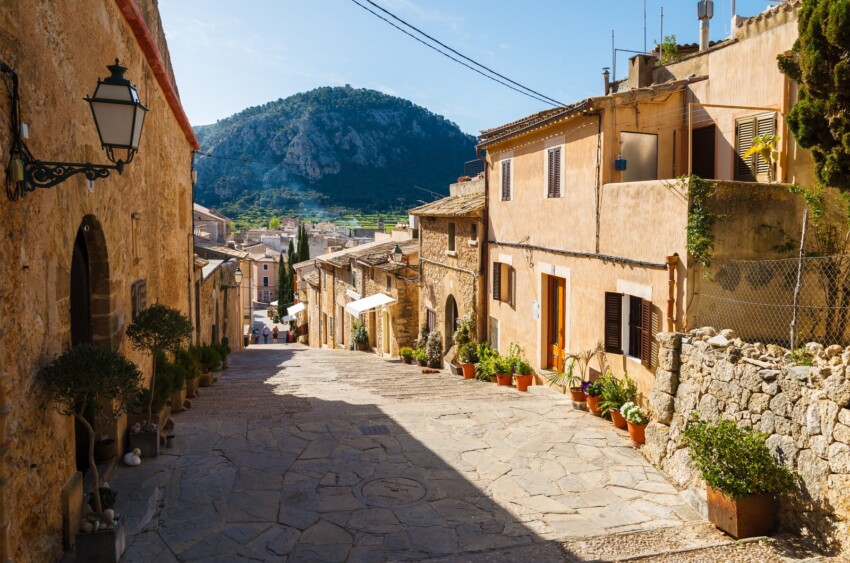
Pollença is a town of medieval origins whose centre is located about 7 km from the coast surrounded by the hills of the Serra de Tramuntana. The town’s name actually derives from the ancient Roman settlement of Pollentia, whose centre at the time was a few kilometres away from modern Pollença. Take some time to explore the town centre with its narrow cobbled streets, stone houses and old churches. Don’t miss a visit to Plaça Major where you will find the Church of Our Lady of the Angels, which was built by the Knights Templar in the 13th century.
Other sites worth a visit include the Cloister of Sant Domingo, the Jesuit school and the Calvary, a staircase of 365 steps that provides a truly breathtaking viewpoint. Like many other towns on the island, Pollenca also has a historical centre inland and a port area along the coast. Port de Pollença is the coastal resort that is now considered a popular destination for many tourists and especially for families with children who greatly appreciate both the beaches and the town’s facilities.
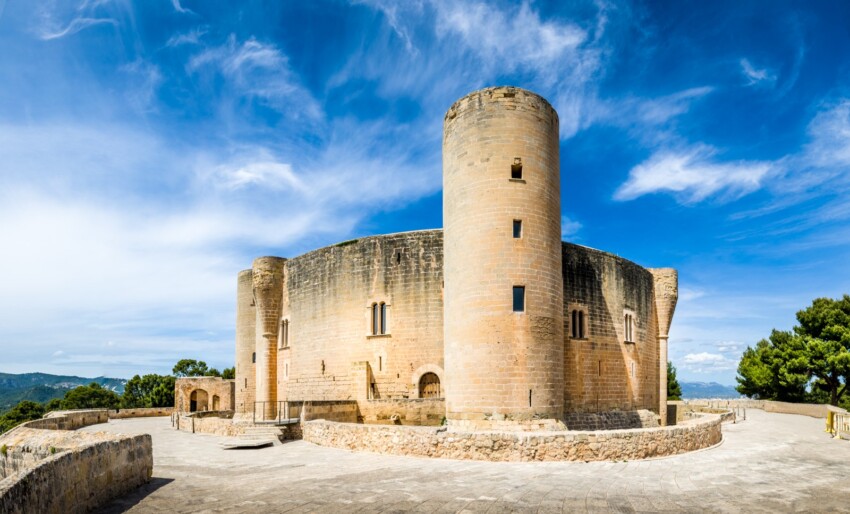
One of the must-see sights in Palma is a visit to the Bellver Castle, located on a hilltop at an altitude of 112 metres. The construction of the castle dates back to the 14th century at the behest of King Jaime II of Majorca. Built in Gothic style, this is one of the few circular castles in Europe.
The fortress was first a royal residence and then a military prison and now houses the city’s History Museum. It is also worth a visit for the beautiful panorama that can be enjoyed from up there over the entire surrounding area. The site can be reached comfortably by car or on foot.
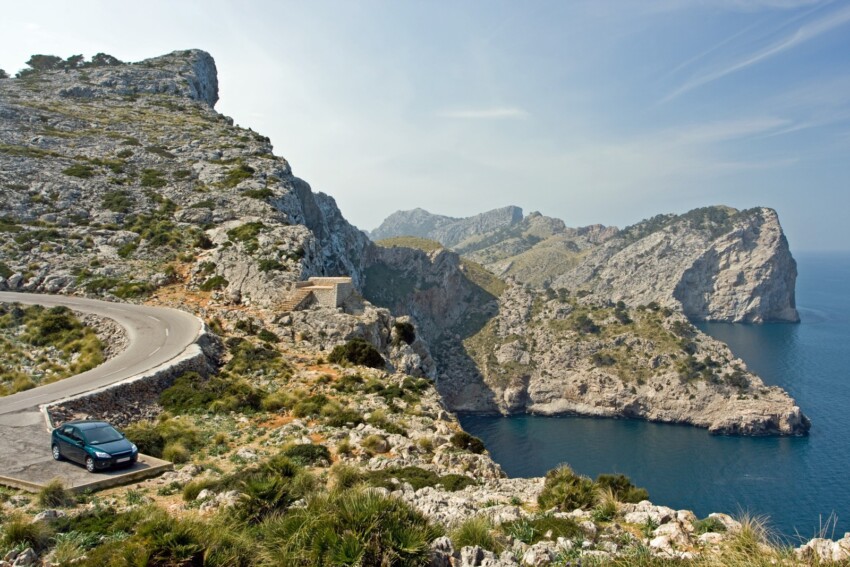
Majorca is a destination for everyone because it encompasses beautiful beaches, historic towns but also mountains. In particular, the Sierra de Tramontana is a mountain range on the island that was added to the UNESCO World Heritage list in 2011. The Sierra de Tramontana runs from north to south, i.e. from Sant’Elm to the Lighthouse of Formentor, and runs along the north-west coast creating unique and beautiful landscapes.
Here you can admire the mountains plunging into the sea, so much so that the famous beach of La Calobra also belongs to the Sierra de Tramontana. As well as being a mountain range, the Sierra de Tramontana is also a comarca, i.e. a territorial subdivision that includes several municipalities within it and has more than 100,000 inhabitants.
Years ago, this was a wild environment, but the local populations have been able to make the most of its characteristics and so an area has been created that knows how to combine mountain, sea and agricultural environments within it. In particular, the land used for agriculture is characterised by terracing, mills, dry stone buildings and the cultivation of olives, vines, almonds and oranges.
The mountainous areas, on the other hand, are ideal for lovers of outdoor activities. You can discover these areas on foot or by bicycle thanks to the numerous paths and trails of varying length and difficulty. The highest peak in the chain is the Puig Mayor, which, at 1,436 metres, is also the highest peak in Majorca and all the Balearic Islands.
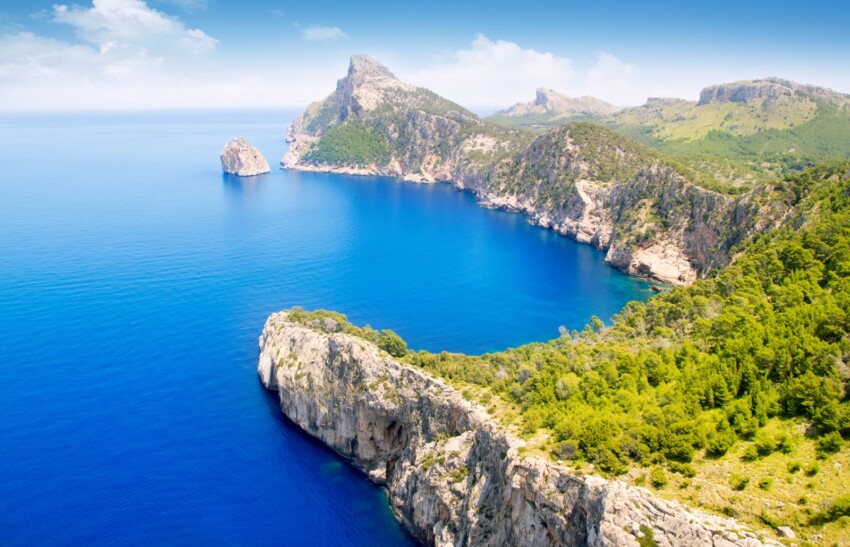
If you are looking for a place to watch the sunset in Majorca, the Cap de Formentor lighthouse is definitely one of the right places. Situated at the end of the cape of the same name, the Formentor Lighthouse stands at the end of the wild tongue of land that runs from the Sierra de Tramuntana down to the sea, developing between coves, overhangs and natural terraces. The lighthouse is located at the most northerly geographical point of the entire Majorca and to get there you have to drive along a narrow and impassable road.
The area boasts diverse landscapes such as steep cliffs, small bays (such as Cala Formentor) and forests with maquis vegetation. In the middle of the day, the final stretch of road to the lighthouse is closed to traffic and from the barrier it is possible to use the shuttle buses or reach the site on foot.
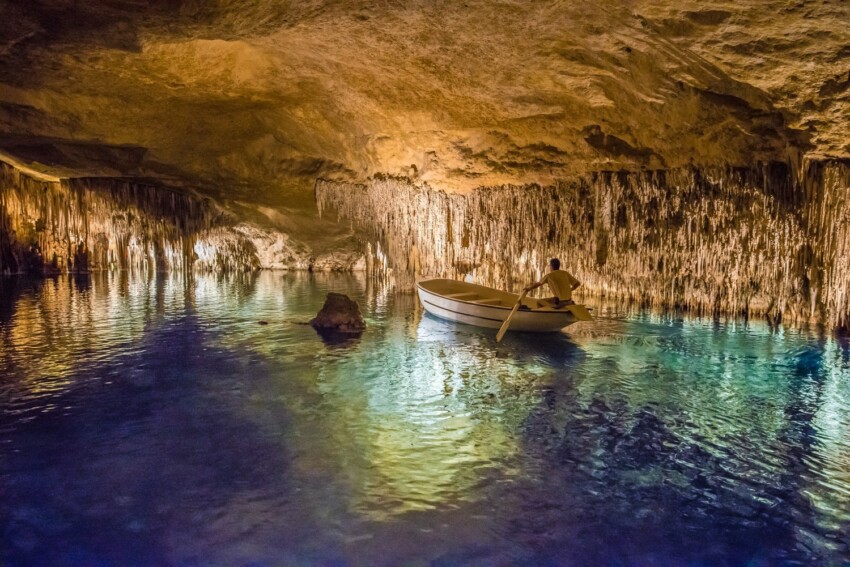
Majorca not only boasts a beautiful historical and natural heritage on the surface but also in its underwater depths. Being a karstic island, the action of water has shaped magnificent underwater caves over millions of years and created spectacular complexes of stalactites, stalagmites and underground lakes.
One of the most famous caves is undoubtedly the Cuevas del Drach, or ‘Dragon Caves’, which is actually a complex of four connected caves several kilometres long. There is also an underground lake in this area, Lake Martel, which is an impressive 115 metres long and 30 metres wide. This particular body of water often hosts special classical music concerts and performances. Other famous caves include the Cova Tancada or the Cova del Pilar.

The Rafa Nadal Museum Xperience is a museum that attracts tennis fans and more. Inside, you can retrace the career of the great tennis champion Rafael Nadal Parera, known as Rafa, who was born in Majorca on 3 June 1986.
Amongst the rooms one can admire the best moments of Rafa Nadal’s sporting career from when he started playing tennis as a child in Manacor until today. In addition to numerous cups and medals, there are also several racquets and numerous accessories used by the great tennis player.
The museum also offers interactive experiences and allows visitors to test their skills with simulators in some of the most popular sports. Here, in fact, it is possible to practice different sports such as tennis, rowing, Formula 1, and many other activities in an innovative and technological environment thanks to various virtual reality platforms!
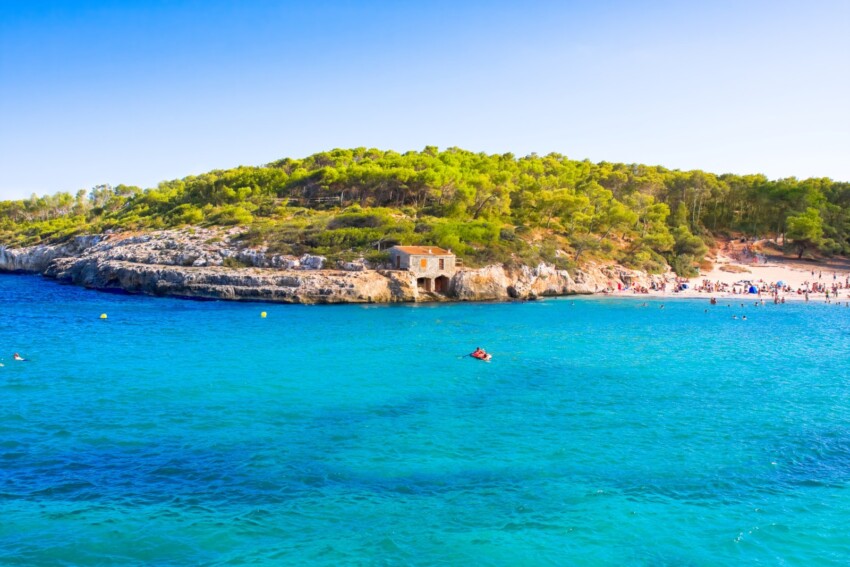
Few people know it, but Majorca is an island rich in parks and nature reserves. One of the most famous is the S’Albufera Nature Park, which is a site of great natural interest due to the biodiversity it holds. This was actually an ancient lagoon separated from the sea by a series of dunes that can still be explored on foot or by bicycle.
Another unspoilt area is the Cabrera archipelago, which boasts one of the best seabeds in the Mediterranean. Also worth a visit are the Dragonera Park and the Mondragò Reserve, which consists of dunes, streams, coral-like marine deposits and mangrove forests.
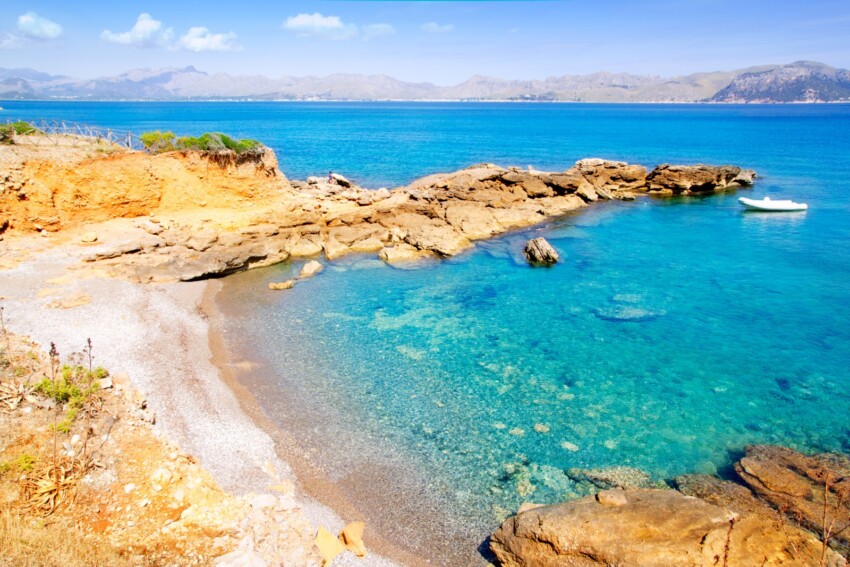
Majorca is famous for its beautiful beaches. Here you can find long sandy beaches, small bays, rocky coves but also wild and hidden sandy shores. Whether you want a coastline with services or a free beach, Majorca can satisfy all your needs. The characteristic that unites all these places is the crystal-clear, transparent sea.
Among the busiest and most serviced beaches are the bay of Pollença, the beach of Palma or the beach of S’Arenal. Those seeking quieter areas, on the other hand, can visit Port de Sóller, Cala Mondragó or Cala Mitjana.
In the following map you can see the location of the main places of interest mentioned in this article.
